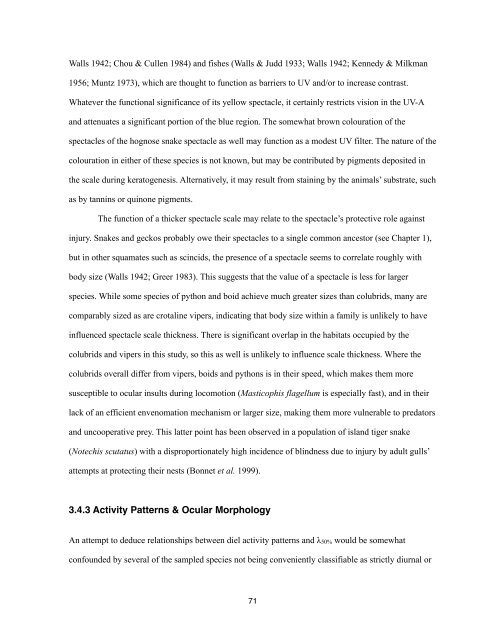Chapter 1, The Reptilian Spectacle - UWSpace - University of ...
Chapter 1, The Reptilian Spectacle - UWSpace - University of ...
Chapter 1, The Reptilian Spectacle - UWSpace - University of ...
You also want an ePaper? Increase the reach of your titles
YUMPU automatically turns print PDFs into web optimized ePapers that Google loves.
Walls 1942; Chou & Cullen 1984) and fishes (Walls & Judd 1933; Walls 1942; Kennedy & Milkman<br />
1956; Muntz 1973), which are thought to function as barriers to UV and/or to increase contrast.<br />
Whatever the functional significance <strong>of</strong> its yellow spectacle, it certainly restricts vision in the UV-A<br />
and attenuates a significant portion <strong>of</strong> the blue region. <strong>The</strong> somewhat brown colouration <strong>of</strong> the<br />
spectacles <strong>of</strong> the hognose snake spectacle as well may function as a modest UV filter. <strong>The</strong> nature <strong>of</strong> the<br />
colouration in either <strong>of</strong> these species is not known, but may be contributed by pigments deposited in<br />
the scale during keratogenesis. Alternatively, it may result from staining by the animals’ substrate, such<br />
as by tannins or quinone pigments.<br />
<strong>The</strong> function <strong>of</strong> a thicker spectacle scale may relate to the spectacle’s protective role against<br />
injury. Snakes and geckos probably owe their spectacles to a single common ancestor (see <strong>Chapter</strong> 1),<br />
but in other squamates such as scincids, the presence <strong>of</strong> a spectacle seems to correlate roughly with<br />
body size (Walls 1942; Greer 1983). This suggests that the value <strong>of</strong> a spectacle is less for larger<br />
species. While some species <strong>of</strong> python and boid achieve much greater sizes than colubrids, many are<br />
comparably sized as are crotaline vipers, indicating that body size within a family is unlikely to have<br />
influenced spectacle scale thickness. <strong>The</strong>re is significant overlap in the habitats occupied by the<br />
colubrids and vipers in this study, so this as well is unlikely to influence scale thickness. Where the<br />
colubrids overall differ from vipers, boids and pythons is in their speed, which makes them more<br />
susceptible to ocular insults during locomotion (Masticophis flagellum is especially fast), and in their<br />
lack <strong>of</strong> an efficient envenomation mechanism or larger size, making them more vulnerable to predators<br />
and uncooperative prey. This latter point has been observed in a population <strong>of</strong> island tiger snake<br />
(Notechis scutatus) with a disproportionately high incidence <strong>of</strong> blindness due to injury by adult gulls’<br />
attempts at protecting their nests (Bonnet et al. 1999).<br />
3.4.3 Activity Patterns & Ocular Morphology<br />
An attempt to deduce relationships between diel activity patterns and λ50% would be somewhat<br />
confounded by several <strong>of</strong> the sampled species not being conveniently classifiable as strictly diurnal or<br />
71
















